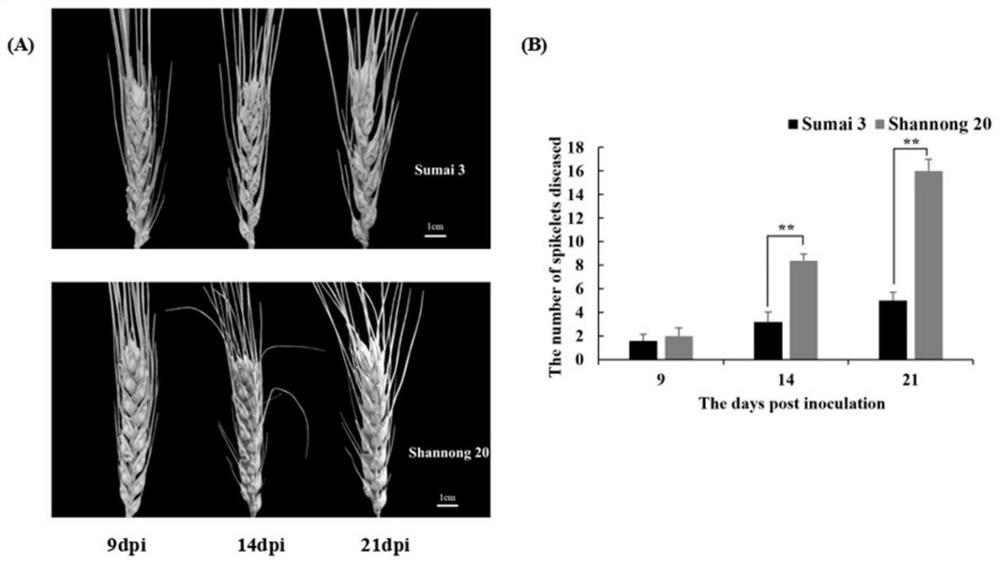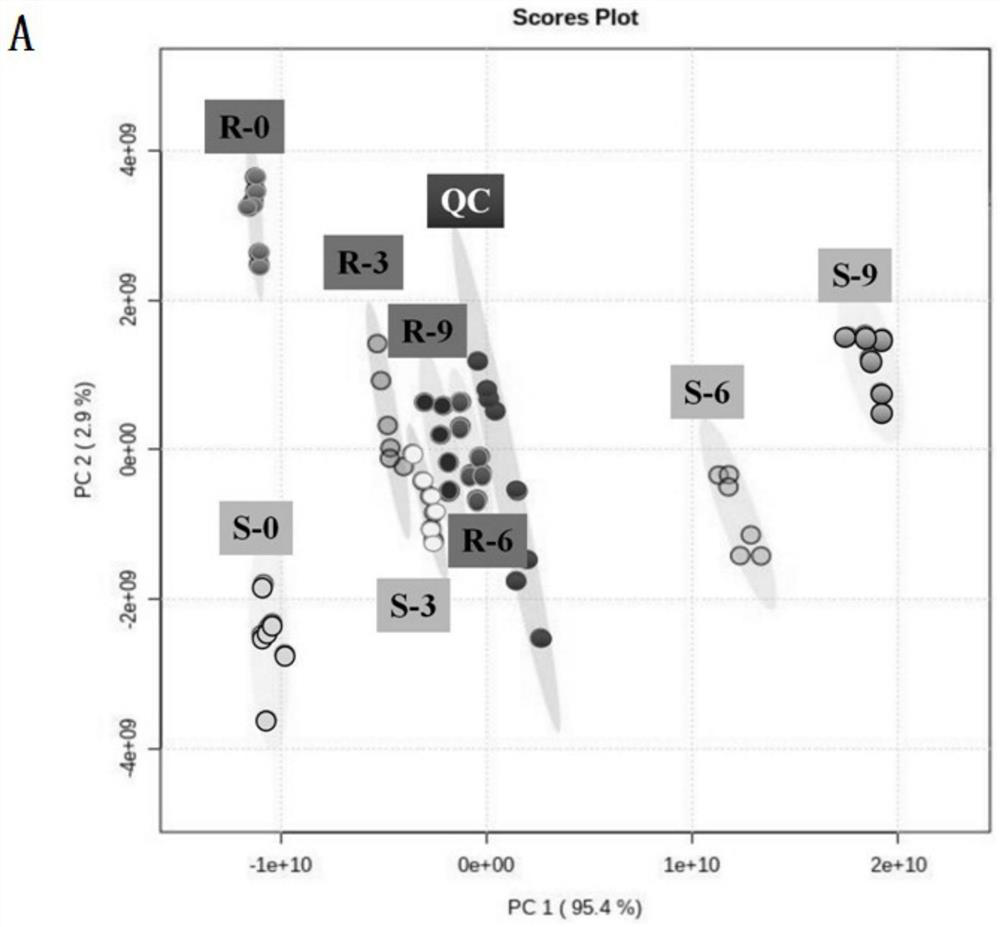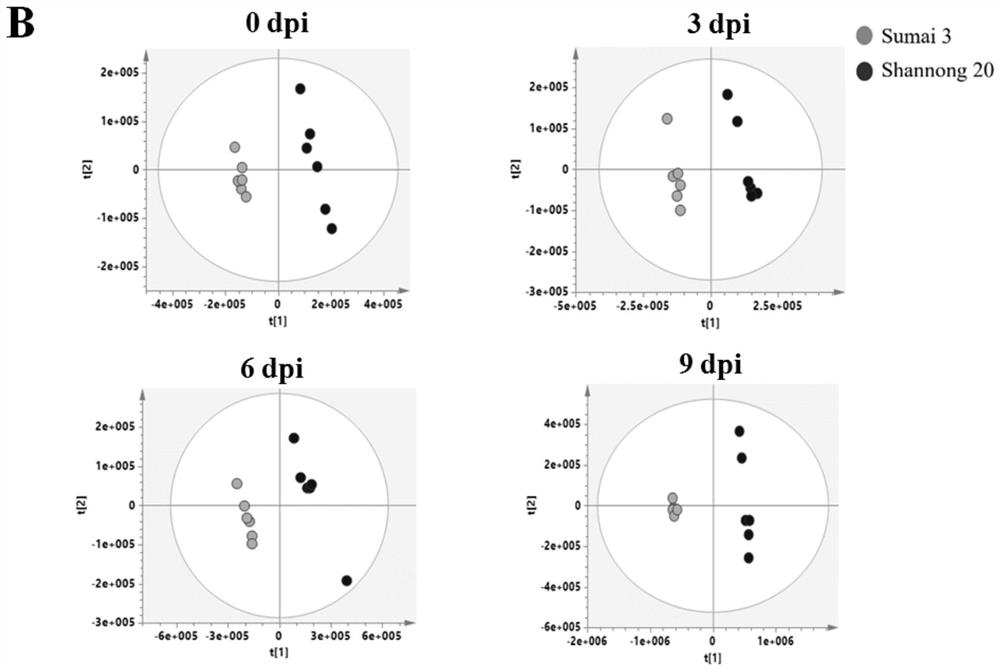Application of proline and alanine in prevention and treatment of wheat scab
A technology of wheat scab and alanine, which is applied in the field of metabolomics to achieve the effect of improving resistance
- Summary
- Abstract
- Description
- Claims
- Application Information
AI Technical Summary
Problems solved by technology
Method used
Image
Examples
Embodiment 1
[0032] Example 1: Phenotypic analysis of the disease-resistant variety Sumai 3 and the susceptible variety Shannong 20 infected with head blight
[0033] 1. Test method:
[0034] (1) Strain activation: The Fusarium graminearum strain used in this experiment was PH-1 strain. The strain was preserved in PDA medium at 4°C, and the strain was activated every three months. Cut one square centimeter of mycelium growth PDA medium with a scalpel and put it into CMC medium. Shake the bacteria at 200 rpm for three days at 28°C. After shaking the bacteria, filter the bacteria solution with a filter cloth, and pack in 50ml centrifuge tubes. Centrifuge at 2000rpm for 10min. Discard the supernatant, add 30ml sterilized water and shake to mix. Discard the supernatant, and resuspend the pellet with a small amount of sterile water. Detect the amount of bacteria under a microscope, and dilute to 1-5×10 according to the amount of spores 5 / ml concentration
[0035] (2) Inoculation method ...
Embodiment 2
[0038] Example 2: Analysis of differential metabolites based on metabolomics
[0039] 1. Non-targeted metabolomics analysis:
[0040] (1) Metabolite extraction method:
[0041] Take the spikelets of Sumai No. 3 and Shannong No. 20 after inoculation (Fusarium graminearum PH-1) 0, 3, 6, and 9 days respectively, grind the spikelet samples, and add the extract (methanol: acetonitrile : water, volume ratio 2:2:1), ultrasonication for 10min, centrifugation at 13000prm for 5min, take the supernatant and transfer it to a centrifuge tube, filter through a 0.22μm filter membrane before sample injection, and then load the sample.
[0042] (2) Liquid phase and mass spectrometry conditions of UPLC-QE-MS:
[0043] Liquid conditions: Chromatographic column: Thermo HYPERSIL GOLD C18 column (2.1×150, 1.7μm); column temperature: 35°C; mobile phase: A: 0.04% acetic acid solution, B: 0.04% acetonitrile; elution gradient: 0- 0.2min, A=90%; 0.2-6min, A decreases to 10%; 6-8min, A=10%; 8.1min, A ...
Embodiment 3
[0061] Example 3: Effects of External Application of Different Types of Amino Acids on Wheat Infection with Scab
[0062] 1. Test method:
[0063] Sensitive wheat Shannong 20 was used as the experimental material. The seeds were first placed at 4°C for 24 hours, then transferred to normal temperature for germination, and then cultivated under 16h light and 8h dark conditions. Take the second leaf of wheat at the three-leaf stage, cut it to 4 cm long, and dip both ends of the isolated leaf into 10 mM amino acids (glycine, methionine, arginine, proline, alanine, and cysteine) For 24 hours, water was used as a control treatment. Then, a wound was lightly poked in the middle of the adaxial surface of the leaf, and Fusarium graminearum PH-1 (3 μL) was inoculated on the wheat leaf. After 3 days, observe and take pictures to record the lesion area on the blade, and statistical data carry out significance analysis.
[0064] In order to further verify the impact of exogenous amino a...
PUM
 Login to View More
Login to View More Abstract
Description
Claims
Application Information
 Login to View More
Login to View More - R&D
- Intellectual Property
- Life Sciences
- Materials
- Tech Scout
- Unparalleled Data Quality
- Higher Quality Content
- 60% Fewer Hallucinations
Browse by: Latest US Patents, China's latest patents, Technical Efficacy Thesaurus, Application Domain, Technology Topic, Popular Technical Reports.
© 2025 PatSnap. All rights reserved.Legal|Privacy policy|Modern Slavery Act Transparency Statement|Sitemap|About US| Contact US: help@patsnap.com



